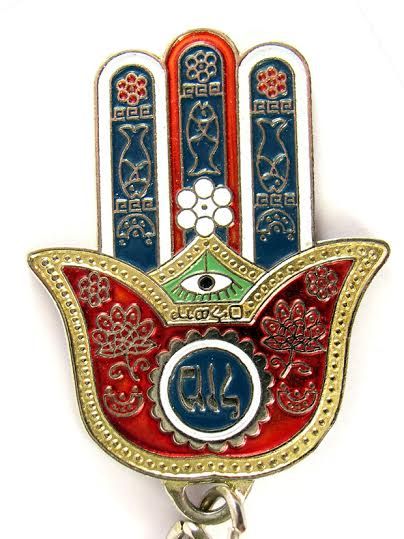The increasing secularity of religious symbols
Published December 11, 2014
In multicultural American society, many people are rooted in different ethnicities, beliefs and backgrounds. As diversity has flourished, so has the assimilation of cultural symbols in fashion, jewelry and art into the secular community. These symbols can be religious, such as a cross or the Star of David, or they can be more obscure like hamsas (an image of a hand with an eye in the center, see an example in the photo at right) or claddaghs (usually rings that display two hands holding a heart in between). This leaves us with the lingering question of whether or not it is disrespectful to wear symbols that do not pertain to one’s own history.
Popular in Israeli and other Middle Eastern cultures, the hamsa’s origin can be traced all the way back to ancient Mesopotamia. The symbol was first used in Islam before Judaism adopted it, although archaeological research shows that the hamsa predates both religions.
In Judaism, it serves as a reminder to praise God with all five senses; that is, to appreciate even the most commonplace blessings such as beautiful landscapes, food, and music. Islam sees the five fingers as a representation of the Five Pillars of Islam or the Five People of the Cloak. The hamsa manifests itself in both Islam and Judaism as an amulet to protect against the “evil eye,” a force rumored to cause sickness, infertility, death and unluckiness.
ADVERTISEMENT
Hamsas are typically worn on necklaces, a trend that still holds true. In the U.S. they are often tattoos. Lizzy Wallis, a former Ladue School District student who now studies at University of Denver, sports the hamsa symbol as a tattoo, and explains that she chose it as a comforting reminder of protection.
“I think that people can still find meaning in [the hamsa] in their own personal way, rather than a religious way, if they are totally non-religious,” Wallis said.
Because the hamsa originated in the Middle East and spread to various regions and religions, it’s understandable that many different types of people would feel attached to the symbol and its meaning. Amanda Lopatin, a senior at Parkway North High School, added that she wears the hamsa because she likes the symbol and finds its origin interesting.
ADVERTISEMENT
Lopatin agreed with Wallis, saying that it is fine for people to wear whatever religious symbol they want. She then clarified, “They should only wear it, though, as long as they know what it means…I hate it when someone who clearly has no knowledge of the hamsa’s meaning is wearing one.”
Another cultural symbol that has made its way into popular fashion and jewelry is the claddagh, a ring believed to be first created in Ireland around 1700. Although it’s a relatively new symbol, it has quickly become an Irish and Irish-Catholic motif of love, often passed through generations maternally.
To Abigail Donahue, a senior at Ladue, people wearing claddaghs without knowledge of their history isn’t a bad choice because the symbol is just pretty.
“My personal reason for wearing a claddagh is because it reminds me of my Irish-Catholic heritage,” Abigail said.
As for crosses, Abigail likes their assimilation into fashion, and doesn’t mind when non-Christians wear them. The cross, the universal symbol for all sects of Christianity, can be seen printed on clothes at stores like Urban Outfitters.
“It’s a little piece of evidence as to how the church and Christ are constantly shaping our lives and culture,” Abigail said. “I think it’s fine when non-Christians wear it. I don’t find it disrespectful unless the cross is upside down or otherwise used to mock Christ.”
Regardless of origin, the timelessness of religious symbols invites fashionistas everywhere.
















